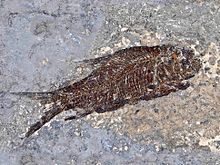Jianghanichthys
| Jianghanichthys Temporal range:
| |
|---|---|

| |
| Fossil of Jianghanichthys hubeiensis from China | |
| Scientific classification | |
| Domain: | Eukaryota |
| Kingdom: | Animalia |
| Phylum: | Chordata |
| Class: | Actinopterygii |
| Order: | Cypriniformes |
| Family: | †Jianghanichthyidae |
| Genus: | †Jianghanichthys Lei, 1987 |
| Species: | †J. hubeiensis
|
| Binomial name | |
| †Jianghanichthys hubeiensis (Lei, 1977)
| |
| Synonyms | |
| |
Jianghanichthys is an extinct genus of Cypriniformes fish. It is also known as Osteohilus or Chan Han Fish.
Taxonomy
There are still disagreements as to the scientific classification, name and age of this species. However the body shape of Jianghanichthys differs from that of all Amyzon species. It has been suggested that the family †Jianghanichthyidae, which is the most basal family of the Cypriniformes, be raised to house this species.[1]
Etymology
The genus name "Jianghanichthys" derives from "Jianghan", the place where it's found, and "ichthys" derives from the Greek word for 'fish'.
Distribution
These fishes lived in the Palaeocene epoch (55 Ma to 65 Ma). Fossils of Jianghanichthys have been found in Hubei, China. These fossils are quite common and can be found in most shops.
References
- Organism Names
- Enciclopaedia of Life
- Fish, Reptilia & Mammalia. Biostratigraphy of the Yangtze Gorge area. Volume 5. Cretaceous and Tertiary., Geological Publishing House, Beijing, 1987: 133-187. Chapter pagination: 187-200. Zoological Record Volume 127
- Juan Liu, Mee-mann Chang A new Eocene catostomid (Teleostei: Cypriniformes) from northeastern China and early divergence of Catostomidae
- Universal Biological Indexer
- LIU Juan, TSENG Zhijie J., WILSON Mark V., MURRAY Alison M. - ASIAN FOSSIL CATOSTOMIDS AND ONTOGENETC CHANGE IN EARLY CYPRINIFORMS
- Specific
- ^ Juan Liu; Mee-Mann Chang; Mark V.H. Wilson; Alison M. Murray (2014). "A New Family of Cypriniformes (Teleostei, Ostariophysi) Based on a Redescription of †Jianghanichthys hubeiensis (Lei, 1977) from the Eocene Yangxi Formation of China (abstract)". Journal of Vertebrate Paleontology. 35 (6). doi:10.1080/02724634.2015.1004073.
